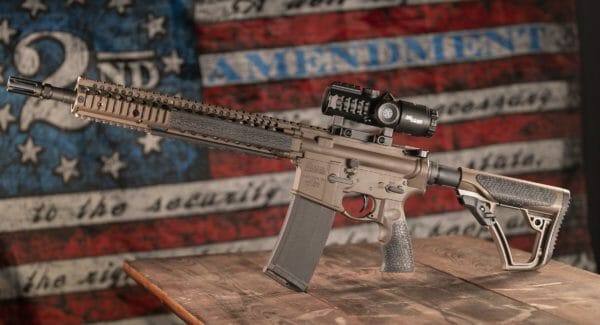
U.S.A. –-(AmmoLand.com)-— On May 11, 2022, a three-judge panel of the Ninth Circuit, based in California, struck down California’s ban on the sale of semi-automatic centerfire rifles to young adults ages 18-20. The case is Jones v. Bonta. Bonta is the current Attorney General of the State of California. The opinion was filed a year after the appeal was submitted on May 12, 2021.
The decision was mixed, with Judges Nelson and Lee in the majority and Judge Stein dissenting.
The District Court had held a requirement to possess a hunting license in order to purchase any long gun which was permissible under the Constitution and intermediate scrutiny. State law was changed while the case was under review to ban nearly all 18-20-year-old people from purchasing centerfire semi-automatic long guns. The plaintiffs were allowed to amend their complaints. The District Court then held the ban on semi-automatic centerfire rifles did not violate the Second Amendment.
The three-judge panel of the Ninth Circuit disagreed. They held the requirement for a hunting license did not violate the Second Amendment, but the ban on the purchase of semi-automatic rifles by 18-20-year-old people violated the Second Amendment. From the decision:
America would not exist without the heroism of the young adults who fought and died in our revolutionary army. Today we reaffirm that our Constitution still protects the right that enabled their sacrifice: the right of young adults to keep and bear arms.
California has restricted the sale of most firearms to anyone under 21. Plaintiffs challenged the bans on long guns and semiautomatic centerfire rifles under the Second Amendment. The district court declined to issue a preliminary injunction.
We hold that the district court did not abuse its discretion in declining to enjoin the requirement that young adults obtain a hunting license to purchase a long gun. But the district court erred in not enjoining an almost total ban on semiautomatic centerfire rifles. First, the Second Amendment protects the right of young adults to keep and bear arms, which includes the right to purchase them. The district court reasoned otherwise and held that the laws did not burden Second Amendment rights at all: that was legal error. Second, the district court properly applied intermediate scrutiny to the long gun hunting license regulation and did not abuse its discretion in finding it likely to survive. But third, the district court erred by applying intermediate scrutiny, rather than strict scrutiny, to the semiautomatic centerfire rifle ban. And even under intermediate scrutiny, this ban likely violates the Second Amendment because it fails the “reasonable fit” test. Finally, the district court also abused its discretion in finding that Plaintiffs would not likely be irreparably harmed. We thus affirm the district court’s denial of an injunction as to the long gun regulation, reverse its denial of an injunction as to the semiautomatic centerfire rifle ban, and remand for further proceedings consistent with this opinion.
The tradition in the Ninth Circuit has become one in which any three-judge panel which upholds a substantive right to arms under the Second Amendment will be re-heard by an en banc panel, where the decision will be reversed. The hostility to the Second Amendment by the Ninth Circuit has become predictable and certain.
The question of age requirements for the exercise of the right to keep and bear arms is under review in other circuits. A Florida law banning the sale of long guns to 18-20-year-old people is in the Fifth Circuit. In the Fourth Circuit, the appeals court struck down a federal law banning sales of handguns to 18-20-year-old people.
The issue is likely to make its way to the Supreme Court.
The Supreme Court has heard the New York Rifle & Pistol Association v. Bruen case; it will likely issue an opinion by the end of June this year, 2022.
The NYR&PA case deals with the right to bear arms outside the home. It is likely to reveal more of the Court’s thinking on the Second Amendment generally. One possibility is it may strike down the convoluted “two-tier” test to determine if a law is permissible under the Second Amendment. The “two tier” test has devolved into a method allowing the courts to find nearly any infringement on Second Amendment rights to be acceptable, according to a member of the Ninth Circuit. From reason.com:
“Our circuit has ruled on dozens of Second Amendment cases,” VanDyke noted, “and without fail has ultimately blessed every gun regulation challenged, so we shouldn’t expect anything less here.”
It is almost certain the Supreme Court decision in the NYR&PA case will be published before an en banc panel is convened to reverse the recent three-judge panel decision in the Ninth Circuit on the ban of the sale of semi-automatic rifles to 18-20-year-old people.
About Dean Weingarten:
Dean Weingarten has been a peace officer, a military officer, was on the University of Wisconsin Pistol Team for four years, and was first certified to teach firearms safety in 1973. He taught the Arizona concealed carry course for fifteen years until the goal of Constitutional Carry was attained. He has degrees in meteorology and mining engineering, and retired from the Department of Defense after a 30 year career in Army Research, Development, Testing, and Evaluation.

from https://ift.tt/4NqF3hp
via IFTTT

No comments:
Post a Comment